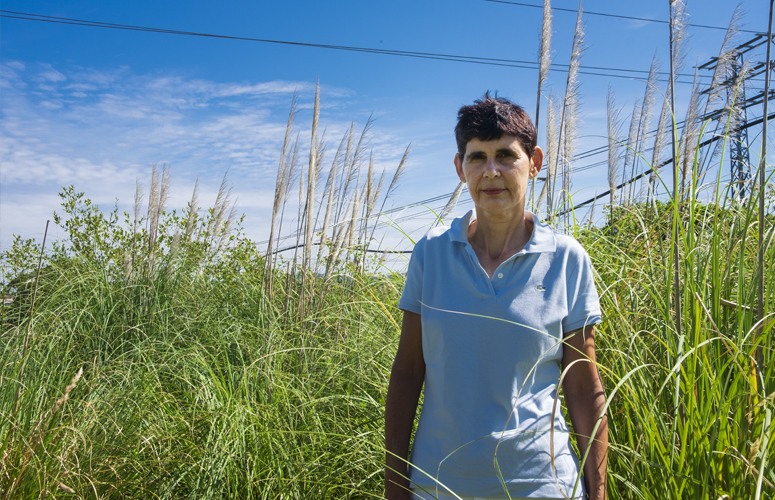Unravelling the keys to the invasion of plant species in Europe
The invasive success of alien species in Europe and its determining factors have been identified by an international research team in which the UPV/EHU-University of the Basque Country has participated
- Research
First publication date: 08/07/2021

The date of introduction and geographic origin largely determine the abundance, geographical extent and ecological breadth of invasive plants; and their biological characteristics, linked to rapid growth, play an important role in that success. These three biological dimensions (abundance, geographic extent and ecological breadth) are fundamental to understanding the success of these invasive species.
This is one of the main conclusions of an international study published in the journal Proceedings of the National Academy of Sciences of the United States of America and entitled Dimensions of invasiveness: links between local abundance, geographic range size and habitat breadth in Europe’s alien and native floras. The Basque Government is one of the sponsors of the project through its scheme to support research groups via the Basque university system (IT936-16). Dr Idoia Biurrun, lecturer in the Department of Plant Biology and Ecology at the UPV/EHU’s Faculty of Science and Technology, has participated in this important research by providing data on the presence and abundance of alien plants in plant communities in the north of the Iberian Peninsula, as well as by collaborating on the interpretation of the results of the study. These data, combined with data from across Europe, have been essential for calculating the success of each alien species in the three dimensions: local abundance, geographic extent and ecological breadth. This three-dimensional framework will improve our knowledge about the dynamics of plant distribution and, therefore, help to anticipate and manage future invasions.
Alien plants are those that grow far from their natural habitat, having been introduced into these new territories as a result of human action. Those that are able to establish themselves in these new environments and maintain populations capable of reproducing are naturalised species, some of which become invasive and may have serious ecological and socio-economic impacts. As Idoia Biurrun pointed out, the pampas grass (Cortaderia selloana) and the Japanese knotweed (Reynoutria japonica) are well-known in our area. Not all introduced species are equally "invasive", a concept that expresses their success or effectiveness in invading new habitats. Accordingly, an international team of scientists led by Professor Mark van Kleunen, a world-renowned expert in biological invasions, has investigated the different types of "invasiveness", as well as the potential factors that determine it in the species introduced into Europe.
These three dimensions (local abundance, geographical extent and ecological breadth) were investigated on the continental European level for a large proportion of the flora, both native and alien. Early introduction into Europe and the ability to grow fast are features shared by many "super invaders". These findings improve our knowledge of the distribution of plant species –both invasive and native– and may help to better predict and manage future invasions.
Are all alien species equally invasive?
Experts in the field of ecology are increasingly aware that the term "invasive" does not describe a single feature. There are various characteristics in the distribution of the species that inform us about their possible invasiveness nature. In order to learn more about the different pathways that introduced species may follow to end up invasive, the authors have combined two large databases: the Global Naturalised Alien Flora (GloNAF) database and the European Vegetation Archive (EVA) database.
The study was based on the premise that these dimensions should be related in alien plants, as they are in native distributions. After all, alien species in one place are native somewhere else. The study showed that the associations between the three dimensions (local abundance, geographical extent, ecological breadth) of alien species that are invasive in Europe follow the same pattern as native European flora: plants that are successful in one dimension also tend to be successful in the others.
Factors that determine successful invasion
Despite the similarities between native and alien plants in terms of their association patterns, there is a crucial difference between the two groups: unlike native plants, invasive plants did not evolve in the invaded habitats into which they have recently been introduced. So, as a second objective, the authors of the study proposed that the key determinants or factors in the success of the invasion in each of the three dimensions be identified, regardless of the fact that the three dimensions may be linked to each other.
They found that plants with high values in all three dimensions tend to come from other continents, such as Asia or America, while plants that have been introduced from other parts of Europe tend not to be very successful as invasive species. In addition, extra-European "super-invaders" often have biological properties that help them grow fast in exchange for less developed defence mechanisms. These results support the so-called enemy release hypothesis. The idea is that when invasive species invade new territories, they leave behind many of the pathogens, herbivores and competitors with which they evolved in their native habitats. This allows them to "grow out of control", and this effect can be even more pronounced when in the invasion process continental boundaries, such as oceans or large mountain ranges, have been crossed.
Exceptions to the rule
The scientists also found exceptions to the above rule whereby plants successful in one dimension of invasion are also successful in the other dimensions, and identified some possible causes of these exceptions. For example, the more recent the date of introduction is, the more likely it is that the invasive plant does not obey this rule. This is because these plants are new to the territory and have not yet developed their potential. This means that we should be concerned about invasive plants that are successful in only one dimension but which have been only recently introduced, as they are quite likely to spread in the other dimensions as well. So, this framework of "invasiveness dimensions" is not only an effective tool in explaining current patterns of naturalisation and in improving our understanding of the dynamics of the distribution of the species, it can also help us anticipate future invasions and develop individualised management strategies to control invasive plants better.
Bibliographic reference
- Dimensions of invasiveness: Links between local abundance, geographic range size, and habitat breadth in Europe’s alien and native floras
- PNAS, Proceedings of the National Academy of Sciences of the United States of America 118: e2021173118
- DOI: 10.1073/pnas.2021173118


